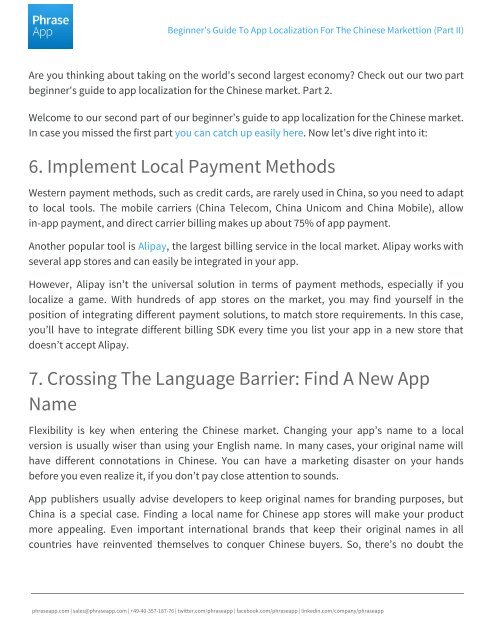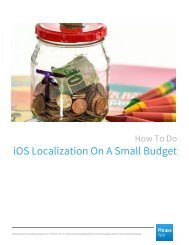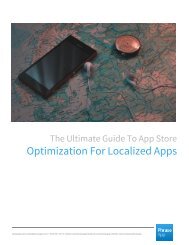Beginner’s Guide To App Localization For The Chinese Market (Part 2)
Are you thinking about taking on the world's second largest economy? Check out our two part beginner's guide to app localization for the Chinese market. Part 2.
Are you thinking about taking on the world's second largest economy? Check out our two part beginner's guide to app localization for the Chinese market. Part 2.
You also want an ePaper? Increase the reach of your titles
YUMPU automatically turns print PDFs into web optimized ePapers that Google loves.
<strong>Beginner’s</strong> <strong>Guide</strong> <strong>To</strong> <strong>App</strong> <strong>Localization</strong> <strong>For</strong> <strong>The</strong> <strong>Chinese</strong> <strong>Market</strong>tion (<strong>Part</strong> II)<br />
Are you thinking about taking on the world's second largest economy? Check out our two part<br />
beginner's guide to app localization for the <strong>Chinese</strong> market. <strong>Part</strong> 2.<br />
Welcome to our second part of our beginner’s guide to app localization for the <strong>Chinese</strong> market.<br />
In case you missed the first part you can catch up easily here. Now let’s dive right into it:<br />
6. Implement Local Payment Methods<br />
Western payment methods, such as credit cards, are rarely used in China, so you need to adapt<br />
to local tools. <strong>The</strong> mobile carriers (China Telecom, China Unicom and China Mobile), allow<br />
in-app payment, and direct carrier billing makes up about 75% of app payment.<br />
Another popular tool is Alipay, the largest billing service in the local market. Alipay works with<br />
several app stores and can easily be integrated in your app.<br />
However, Alipay isn’t the universal solution in terms of payment methods, especially if you<br />
localize a game. With hundreds of app stores on the market, you may find yourself in the<br />
position of integrating different payment solutions, to match store requirements. In this case,<br />
you’ll have to integrate different billing SDK every time you list your app in a new store that<br />
doesn’t accept Alipay.<br />
7. Crossing <strong>The</strong> Language Barrier: Find A New <strong>App</strong><br />
Name<br />
Flexibility is key when entering the <strong>Chinese</strong> market. Changing your app’s name to a local<br />
version is usually wiser than using your English name. In many cases, your original name will<br />
have different connotations in <strong>Chinese</strong>. You can have a marketing disaster on your hands<br />
before you even realize it, if you don’t pay close attention to sounds.<br />
<strong>App</strong> publishers usually advise developers to keep original names for branding purposes, but<br />
China is a special case. Finding a local name for <strong>Chinese</strong> app stores will make your product<br />
more appealing. Even important international brands that keep their original names in all<br />
countries have reinvented themselves to conquer <strong>Chinese</strong> buyers. So, there’s no doubt the<br />
phraseapp.com | sales@phraseapp.com | +49-40-357-187-76 | twitter.com/phraseapp | facebook.com/phraseapp | linkedin.com/company/phraseapp

















